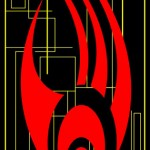Even as their empire expanded to the stars, the Klingons have maintained a feudal social structure. Under such an arrangement, each of the Great Houses are represented on the Klingon High Council. Such a government structure is far from a representative democracy, as only the interests of the highest social class are represented. As a warrior culture, the warrior class is the highest social class.
In the 9th century AD (by the Earth calendar), the three major nations of Qo’Nos were united under the banner of Kahless after he slew the tyrant Molor and conquered the Fek’Ihri. As the first emperor, he established a code of honor roughly similar to the Hamurabic code that became the basis of Klingon society and culture. Prior to Kahless’s rise to power, emperors rose to power through subversion and conquest. The most prominent instance of such an occurrence was the rise of Emperor Sompek and the Sack of Tong Vey (“Rules of Engagement” [DS9]). In early modern times, however, each emperor was descended from Kahless in much the same way that the earliest Islamic leaders were descended from Muhammed up until controversies over the true line of succession arose. Similar controversies likely took place in Klingon history during the interceding fifteen centuries. Furthermore, civil wars were once again commonplace, especially when an emperor left no male heirs. Among the most prominent of power struggles was the execution of Emperor Reclaw I and his entire family. Through succeeding generations, official historical accounts posited that such an uprising never occurred to prevent the Empire from descending into anarchy the likes of which hadn’t been seen since before the time of Kahless, when in fact, members of the first ruling family of the Third Dynasty were given the names and titles of the old royal family to create the illusion of an unbroken line. While such information was readily available by the 24th century, even Lady Sirella, Mistress of the House of Martok, still believed herself to be a descendant of Princess Shenara, daughter of Emperor Reclaw I. (“You Are Cordially Invited…” [DS9])
Over the centuries, the High Council gradually gained political power in much the same way Great Britain’s Parliament grew in political power. By Earth’s late 21st century, the position of emperor had been abolished (“Rightful Heir” [TNG]). Perhaps, at some point, the Empire had experienced a conflict similar to the First English Revolution when the drawbacks to monarchical succession became more and more apparent. Succession, more often that not, falls to the monarch’s closest male heir, and if that monarch is incompetent, his people suffer for it for the rest of his natural life (barring the occasional assassination or coup d’etat) .
After the last emperor’s passing, the head of state for the Empire has seemingly changed in name only. The Chancellor of the High Council holds the position for life. He can overrule a majority vote of the Council at his leisure. Because the Chancellor is the head of an autocracy, he is also known as Supreme Commander of the Klingon Empire. (“Reunion” [TNG])
As of the late 24th century, the Klingon High Council consists of representatives of twenty-four noble houses. That number has fluctuated over time depending on Houses that have gone extinct, have been disbanded or dishonored, and Houses that have been elevated to nobility. The House of Mogh and, possibly, the House of Duras are examples of disbanded or dishonored Houses. (“Redemption, Part II” [TNG], “Past Prologue” [DS9], “Firstborn” [TNG], Star Trek Generations, “The Way of the Warrior” [DS9], “Soldiers of the Empire” [DS9]) On the other hand, the House of Martok rose to noble status through the accolades of its patriarch, a common warrior from Ketha Province who eventually became a general in the Klingon Defense Force and potential successor to Chancellor Gowron. (“Apocalypse Rising” [DS9], “Once More Unto the Breach” [DS9], “Tacking Into the Wind” [DS9])
One can rise to the position of chancellor in three ways:
1) Challenging the sitting chancellor to a fight to the death. If victorious, the challenger can accept the position or turn it over to someone else, usually a member of the High Council (“Tacking Into the Wind” [DS9]).
2) Be named heir to the chancellor, as was the case when Azetbur succeeded her father Gorkon in 2293 following his assassination (Star Trek VI: The Undiscovered Country).
3) If the chancellor leaves no heirs, as was probably the case with K’mpec at the time of his death in 2367, a member of the High Council or other prominent warrior can stake a claim to the chancellorship, which is won by Rite of Succession. (“Reunion” [TNG], “Redemption, Part I” [TNG]) By the latter half of the 24th century, this was probably the most common method of succession outside of assassinating an unfit leader. In some cases where the chancellor did leave an heir, an Arbiter of Succession may reject his or her claim on the basis of having “won no battles, or shed no blood for his people.” (“Redemption, Part I” [TNG])
As a general rule, women may not serve on the High Council, nor may be named leaders of their Houses (“Redemption, Part I” [TNG], “The House of Quark” [DS9]), except under one of two notable circumstances.
1) A chancellor’s daughter is his only heir, as a result of having no sons or all his sons having died in honorable combat. (Star Trek VI: The Undiscovered Country) General Chang, theoretically, could have challenged Azetbur for leadership of the Council. Yet, to avoid exposing his role in the Khitomer Conspiracy too soon, he opted for a more stealthy approach—see that the assassination of the UFP President was carried out in the hope the Federation would retaliate and declare war on the Empire. As one of Chancellor Azetbur’s advisers said, “Better to die on our feet than live on our knees.”
2) If a House patriarch has no male heirs when he is killed in honorable combat, his widow or a female relative may assume leadership of that House if she chooses not to marry the victor in said honorable combat (“The House of Quark” [DS9]). Grilka, Mistress of the House of Kozak, had initially chosen to marry Quark, a Ferengi, in order to prevent rival House leader D’Ghor from laying claim to House Kozak’s assets. This marriage served the secondary purpose of allowing Quark to dig up proof of financial malfeasance on D’Ghor’s part. Once D’Ghor was expelled from the Council by ritual discommendation, Grilka was granted leadership of her House.
Because Duras died in disgrace as a result of Worf, Son of Mogh, having claimed Rite of Vengeance, Lursa and B’Etor were most likely barred from representing the House of Duras on the High Council. And despite tradition that a Great House carries the name of its living patriarch, the name House of Duras remained after his death. Again, this was possibly because of the circumstances of his death or because of the lack of a male figurehead leader. Similarly, the House of Mogh still carried that name after Mogh’s death due to the lack of a single leader coupled with Worf’s service in Starfleet and the Council’s use of the House of Mogh as a scapegoat for the Khitomer Massacre. The second born son of Mogh, Kurn, was eventually granted a seat on the Council after the House of Mogh was formally exonerated. In the interceding years, leadership possibly belonged to a nephew and cousin of Mogh.
In effect, the Klingon political structure still follows feudal traditions, albeit far more complex than most feudal societies on Earth. For example, the notion of fighting and dying for one’s own nation did not arise in western Europe until early modern times. In the Klingon Empire, however, the noble Houses control their own armies (those who fought the most recent civil war) while a single entity that is loyal to the Empire as a whole comprise the bulk of their military forces (the Klingon Defense Forces). To what extent these political traditions remain in the near future is uncertain since as an outside observer suggested, “The Klingon Empire is dying, and I think it deserves to die.”








Recent Comments